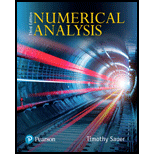
Numerical Analysis
3rd Edition
ISBN: 9780134696454
Author: Sauer, Tim
Publisher: Pearson,
expand_more
expand_more
format_list_bulleted
Question
Chapter 8.1, Problem 7CP
To determine
To find: The smallest C for which the given population on the patch [0, 10] survives in the long run, Use the Crank-Nicolson method to approximate the solution, and try to confirm that your result do not depend on the step size choice. And to compare the result with the survival rule y13y
Expert Solution & Answer
Want to see the full answer?
Check out a sample textbook solution
Students have asked these similar questions
A 20 foot ladder rests on level ground; its head (top) is against a vertical wall. The bottom of the ladder begins by being 12 feet from the wall but begins moving away at the rate of 0.1 feet per second. At what rate is the top of the ladder slipping down the wall? You may use a calculator.
A school counselor is conducting a research study to examine whether there is a relationship between the number of times teenagers report vaping per week and their academic performance, measured by GPA. The counselor collects data from a sample of high school students. Write the null and alternative hypotheses for this study. Clearly state your hypotheses in terms of the correlation between vaping frequency and academic performance.
EditViewInsertFormatToolsTable
12pt
Paragraph
Please help solve the following whilst showing all working out. Is part of exam revision questions but no solution is given
Chapter 8 Solutions
Numerical Analysis
Ch. 8.1 - Prove that the functions (a) u(x,t)=e2t+x+e2tx,...Ch. 8.1 - Prove that the functions (a) u(x,t)=etsinx, (b)...Ch. 8.1 - Prove that if f(x) is a degree 3 polynomial, then...Ch. 8.1 - Prob. 4ECh. 8.1 - Verify the eigenvector equation (8.13).Ch. 8.1 - Show that the nonzero vectors vj in (8.12 ), for...Ch. 8.1 - Prob. 1CPCh. 8.1 - Consider the equation ut=uxx for 0x1, 0t1 with the...Ch. 8.1 - Prob. 3CPCh. 8.1 - Use the Backward Difference Method to solve the...
Ch. 8.1 - Use the Crank-Nicolson Method to solve the...Ch. 8.1 - Prob. 6CPCh. 8.1 - Prob. 7CPCh. 8.1 - Setting C=D=1 in the population model (8.26), use...Ch. 8.2 - Prove that the functions (a) u(x,t)=sinxcos4t, (b)...Ch. 8.2 - Prove that the functions (a) u(x,t)=sinxsin2t, (b)...Ch. 8.2 - Prove that u1(x,t)=sinxcosct and u2(x,t)=ex+ct are...Ch. 8.2 - Prove that if s(X) is twice differentiable, then...Ch. 8.2 - Prove that the eigenvalues of A in (8.33) lie...Ch. 8.2 - Let be a complex number. (a) Prove that if +1/ is...Ch. 8.2 - Solve the initial-boundary value problems in...Ch. 8.2 - Solve the initial-boundary value problems in...Ch. 8.2 - Prob. 3CPCh. 8.2 - Prob. 4CPCh. 8.3 - Show that u(x,y)=ln(x2+y2) is a solution to the...Ch. 8.3 - Prob. 2ECh. 8.3 - Prove that the functions (a) u(x,y)=eysinx, (b)...Ch. 8.3 - Prove that the functions (a) u(x,y)=exy, (b)...Ch. 8.3 - Prove that the functions (a) u(x,y)=sin2xy, (b)...Ch. 8.3 - Prove that the functions (a) u(x,y)=ex+2y, (b)...Ch. 8.3 - Prob. 7ECh. 8.3 - Show that the barycenter of a triangle with...Ch. 8.3 - Prove Lemma 8.9 .Ch. 8.3 - Prove Lemma 8.10.Ch. 8.3 - Prob. 11ECh. 8.3 - Prob. 12ECh. 8.3 - Prob. 13ECh. 8.3 - Solve the Laplace equation problems in Exercise 3...Ch. 8.3 - Prob. 2CPCh. 8.3 - Prob. 3CPCh. 8.3 - Prob. 4CPCh. 8.3 - Prob. 5CPCh. 8.3 - The steady-state temperature u on a heated copper...Ch. 8.3 - Prob. 7CPCh. 8.3 - Prob. 8CPCh. 8.3 - Solve the Laplace equation problems in Exercise 3...Ch. 8.3 - Solve the Poisson equation problems in Exercise 4...Ch. 8.3 - Solve the elliptic partial differential equations...Ch. 8.3 - Prob. 12CPCh. 8.3 - Prob. 13CPCh. 8.3 - Solve the elliptic partial differential equations...Ch. 8.3 - Prob. 15CPCh. 8.3 - Prob. 16CPCh. 8.3 - For the elliptic equations in Exercise 7, make a...Ch. 8.3 - Solve the Laplace equation with Dirichlet boundary...Ch. 8.4 - Show that for any constant c, the function...Ch. 8.4 - Show that over an interval [ x1,xr ] not...Ch. 8.4 - Prob. 3ECh. 8.4 - Prob. 4ECh. 8.4 - Prob. 5ECh. 8.4 - Prob. 6ECh. 8.4 - Prob. 1CPCh. 8.4 - Prob. 2CPCh. 8.4 - Solve Fishers equation (8.69) with...Ch. 8.4 - Prob. 4CPCh. 8.4 - Solve the Brusselator equations for...Ch. 8.4 - Prob. 6CP
Knowledge Booster
Learn more about
Need a deep-dive on the concept behind this application? Look no further. Learn more about this topic, subject and related others by exploring similar questions and additional content below.Similar questions
- Explain the relationship between 12.3.6, (case A of 12.3.6) and 12.3.7arrow_forwardExplain the key points and reasons for the establishment of 12.3.2(integral Test)arrow_forwardUse 12.4.2 to determine whether the infinite series on the right side of equation 12.6.5, 12.6.6 and 12.6.7 converges for every real number x.arrow_forward
- use Corollary 12.6.2 and 12.6.3 to derive 12.6.4,12.6.5, 12.6.6 and 12.6.7arrow_forwardExplain the focus and reasons for establishment of 12.5.1(lim(n->infinite) and sigma of k=0 to n)arrow_forwardExplain the focus and reasons for establishment of 12.5.3 about alternating series. and explain the reason why (sigma k=1 to infinite)(-1)k+1/k = 1/1 - 1/2 + 1/3 - 1/4 + .... converges.arrow_forward
arrow_back_ios
SEE MORE QUESTIONS
arrow_forward_ios
Recommended textbooks for you
 Algebra & Trigonometry with Analytic GeometryAlgebraISBN:9781133382119Author:SwokowskiPublisher:Cengage
Algebra & Trigonometry with Analytic GeometryAlgebraISBN:9781133382119Author:SwokowskiPublisher:Cengage Glencoe Algebra 1, Student Edition, 9780079039897...AlgebraISBN:9780079039897Author:CarterPublisher:McGraw Hill
Glencoe Algebra 1, Student Edition, 9780079039897...AlgebraISBN:9780079039897Author:CarterPublisher:McGraw Hill Trigonometry (MindTap Course List)TrigonometryISBN:9781337278461Author:Ron LarsonPublisher:Cengage Learning
Trigonometry (MindTap Course List)TrigonometryISBN:9781337278461Author:Ron LarsonPublisher:Cengage Learning


Algebra & Trigonometry with Analytic Geometry
Algebra
ISBN:9781133382119
Author:Swokowski
Publisher:Cengage

Glencoe Algebra 1, Student Edition, 9780079039897...
Algebra
ISBN:9780079039897
Author:Carter
Publisher:McGraw Hill

Trigonometry (MindTap Course List)
Trigonometry
ISBN:9781337278461
Author:Ron Larson
Publisher:Cengage Learning
Hypothesis Testing using Confidence Interval Approach; Author: BUM2413 Applied Statistics UMP;https://www.youtube.com/watch?v=Hq1l3e9pLyY;License: Standard YouTube License, CC-BY
Hypothesis Testing - Difference of Two Means - Student's -Distribution & Normal Distribution; Author: The Organic Chemistry Tutor;https://www.youtube.com/watch?v=UcZwyzwWU7o;License: Standard Youtube License